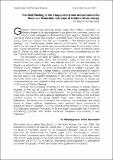Files in this item
The wall painting of the Chapel-martyrium Motsameta in the rock–cut monastery complex of Udabno David–Gareji.
Item metadata
| dc.contributor.author | Khoshtaria, Tinatin. | |
| dc.contributor.editor | University of St Andrews. School of Art History. | |
| dc.date.accessioned | 2008-12-19T14:06:48Z | |
| dc.date.available | 2008-12-19T14:06:48Z | |
| dc.date.issued | 2004 | |
| dc.identifier.citation | Inferno: Journal of Art History Vol. 9 Article 2 2004 | en |
| dc.identifier.issn | 1355-5596 | en |
| dc.identifier.uri | https://hdl.handle.net/10023/619 | |
| dc.description | Previously in the University eprints HAIRST pilot service at http://eprints.st-andrews.ac.uk/archive/00000390/ | en |
| dc.description | Article 2 of 6 in an issue devoted to the visual culture of South Eastern Europe | en |
| dc.description.abstract | Among the numerous churches of the monasteries of Gareji, there is situated at the top of a mountain in west of the mine complex, the little church of the Forty Martyrs, or Motsameta. The paintings of this chapel-martyrium, Motsameta, have special significance in the study of the Garejian painting school. In the Gareji desert there were other martyriums, in Sabereebi, Bertubani and Tsamebuli for example, but paintings are rarely found in these edifices. Martyriums were painted more commonly in Byzantium than in Georgia. Thus the church of Motsameta is a rare example of a Georgian painted martyrium. Its further study, particularly with the aim of establishing parallels with similar medieval European monuments, is very important. | en |
| dc.format.extent | 121916 bytes | |
| dc.format.mimetype | application/pdf | |
| dc.language.iso | en | en |
| dc.publisher | School of Art History, University of St Andrews | en |
| dc.subject | Georgia | en |
| dc.subject | Chubinashvili | en |
| dc.subject | eleventh century | en |
| dc.subject | thirteenth century | en |
| dc.subject.lcc | N1.I6 | en |
| dc.title | The wall painting of the Chapel-martyrium Motsameta in the rock–cut monastery complex of Udabno David–Gareji. | en |
| dc.type | Journal article | en |
| dc.description.version | https://doi.org/Postprint | en |
| dc.publicationstatus | Published | en |
| dc.status | Peer reviewed | en |
This item appears in the following Collection(s)
Items in the St Andrews Research Repository are protected by copyright, with all rights reserved, unless otherwise indicated.

